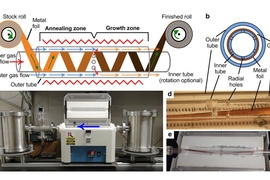Graphene is a material with a host of potential applications, including in flexible light sources, solar panels that could be integrated into windows, and membranes to desalinate and purify water. But all these possible uses face the same big hurdle: the need for a scalable and cost-effective method for continuous manufacturing of graphene films.
That could finally change with a new process described this week in the journal Scientific Reports by researchers at MIT and the University of Michigan. MIT mechanical engineering Associate Professor A. John Hart, the paper’s senior author, says the new roll-to-roll manufacturing process described by his team addresses the fact that for many proposed applications of graphene and other 2-D materials to be practical, “you’re going to need to make acres of it, repeatedly and in a cost-effective manner.”
Making such quantities of graphene would represent a big leap from present approaches, where researchers struggle to produce small quantities of graphene — often pulling these sheets from a lump of graphite using adhesive tape, or producing a film the size of a postage stamp using a laboratory furnace. But the new method promises to enable continuous production, using a thin metal foil as a substrate, in an industrial process where the material would be deposited onto the foil as it smoothly moves from one spool to another. The resulting sheets would be limited in size only by the width of the rolls of foil and the size of the chamber where the deposition would take place.
Because a continuous process eliminates the need to stop and start to load and unload materials from a fixed vacuum chamber, as in today’s processing methods, it could lead to significant scale-up of production. That could finally unleash applications for graphene, which has unique electronic and optical properties and is one of the strongest materials known.
The new process is an adaptation of a chemical vapor deposition method already used at MIT and elsewhere to make graphene — using a small vacuum chamber into which a vapor containing carbon reacts on a horizontal substrate, such as a copper foil. The new system uses a similar vapor chemistry, but the chamber is in the form of two concentric tubes, one inside the other, and the substrate is a thin ribbon of copper that slides smoothly over the inner tube.
Gases flow into the tubes and are released through precisely placed holes, allowing for the substrate to be exposed to two mixtures of gases sequentially. The first region is called an annealing region, used to prepare the surface of the substrate; the second region is the growth zone, where the graphene is formed on the ribbon. The chamber is heated to approximately 1,000 degrees Celsius to perform the reaction.
The researchers have designed and built a lab-scale version of the system, and found that when the ribbon is moved through at a rate of 25 millimeters (1 inch) per minute, a very uniform, high-quality single layer of graphene is created. When rolled 20 times faster, it still produces a coating, but the graphene is of lower quality, with more defects.
Some potential applications, such as filtration membranes, may require very high-quality graphene, but other applications, such as thin-film heaters may work well enough with lower-quality sheets, says Hart, who is the Mitsui Career Development Associate Professor in Contemporary Technology at MIT.
So far, the new system produces graphene that is “not quite [equal to] the best that can be done by batch processing,” Hart says — but “to our knowledge, it’s still at least as good” as what’s been produced by other continuous processes. Further work on details such as pretreatment of the substrate to remove unwanted surface defects could lead to improvements in the quality of the resulting graphene sheets, he says.
The team is studying these details, Hart adds, and learning about tradeoffs that can inform the selection of process conditions for specific applications, such as between higher production rate and graphene quality. Then, he says, “The next step is to understand how to push the limits, to get it 10 times faster or more.”
Hart says that while this study focuses on graphene, the machine could be adapted to continuously manufacture other two-dimensional materials, or even to growing arrays of carbon nanotubes, which his group is also studying.
“This is high-quality research that represents significant progress on the path to scalable production methods for large-area graphene,” says Charlie Johnson, a professor of physics and astronomy at the University of Pennsylvania who was not involved in this work. “I think that the concentric tube approach is very creative. It has the potential to lead to significantly lower production costs for graphene, if it can be scaled to larger copper-foil widths.”
The research team also included Erik Polsen and Daniel McNerny of the University of Michigan and postdocs Viswanath Balakrishnan and Sebastian Pattinson of MIT. The work was supported by the National Science Foundation and the Air Force Office of Scientific Research.












